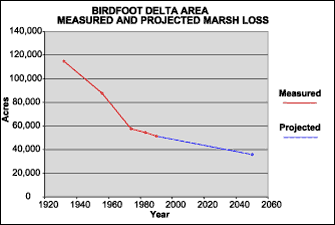| |  |  | | Lake Pontchartrain Atlas: | |  | | |  | | |  | | |  | | |  | | Environmental Status & Trends |  | |  | | |  | | |  | | |  | | |  | | |  | | |  | | |  | | |  |  | |  | |  | | |  |  |  | | | |  | Environmental Status and Trends - Status and Trends of the Lake Pontchartrain Basin Contributors: Penland, Maygarden, Beall  | | Figure 20: Measured marsh loss in the Birdfoot Delta Area between 1932 and 1990 with projection to 2050 (Coast 2050, 1998). Refer to Table 5 for marsh loss comparison. | The Birdfoot Delta Area (BDA) encompasses a variety of marsh types that lie between the main stream of the Mississippi River and South Pass (Figures 1 and 14). The fresh, intermediate, brackish and saline marshes of the area are associated with the distributary channels of Baptiste Collette Bayou, Cubit's Gap and Pass à Loutre. The Birdfoot Delta of the Mississippi River is one of the most rapidly eroding areas in coastal Louisiana (Figure 20). The area lost 63,490 acres or 50% of its land area between 1932 and 1990. A combination of subsidence, altered hydrology and hurricanes contributed to this loss. If nothing is done to curb this loss, another 15,610 acres of marsh will likely be lost by 2050 (Table 5). Restoration projects designed to reverse this trend include use of dredged material to create a potential total of 2,000 new marsh acres. By creating crevasses, the CWPPRA program hopes to create another 2,090 acres of marsh by 2050. Tables 2, 3 and 4, show population trends for a selection of fish and wildlife species of the BDA. The estuarine-dependent fish species of this area have been generally steady, but many are likely to decrease in the near future. The brown pelican is the only wildlife species showing increasing population over the last 10 to 20 years. Most of the other species of wildlife are expected to show steady population numbers through 2050, while the alligator has had decreasing populations over this period. « Previous | Next » |

